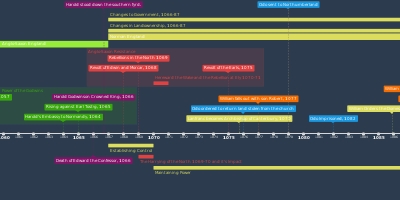Changes to Government, 1066-87 (25 dic 1066 año – 9 sept 1087 año)
Descripción:
Centralised Power:-William owned all the land in England which he could use to reward and punish followers.
-The Feudal System
-The church was normanised.
-The demesne
-The Domesday Book recorded the worth of every area.
-William earned money through tax.
Reduced Use of Earls:
-Earldoms were made smaller and more compact.
-This meant earls could never become as powerful as him or challenge him.
-This did lead to some resentment in the loss of power.
Role of Regents:
-William left those he trusted as regents in his stead.
-He returned as soon as any trouble was aware of.
Sheriffs:
-Kept the same duties of being the king's representative, collecting taxes and upholding law and justice.
-The roles began to be replaced by Normans, so rebellions were less likely.
-They also had more power as they answered to no one but the king.
-Many were unpopular as they abused their powers by land-grabbing to increase their wealth.
The Forest:
The king loved hunting and kept a lot of land in order to extend his hunting land in his demesne by taking land off other landholders.
The forest was land reserved for hunting and had its own laws.
Animals were protected, dogs and weapons were banned from entering, and no wood could be cut down.
Significance:
-Showed the extent of power of the king.
-Made the act of land-grabbing seem more legitimate as that was effectively how he extended his forest land.
-Harsh punishments for the breaking of the laws showed the brutality of the Norman rule.
-William earned money through fines.
Añadido al timeline:
fecha:
25 dic 1066 año
9 sept 1087 año
~ 20 years
